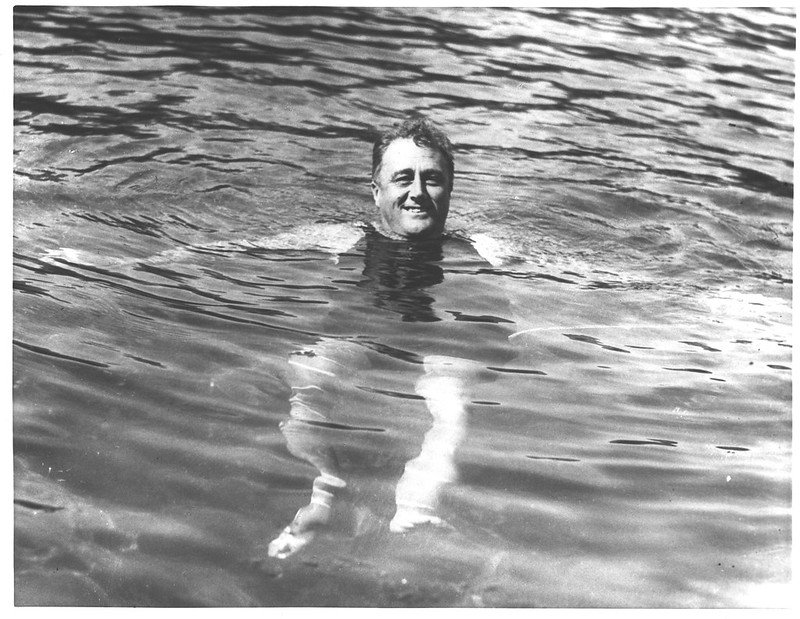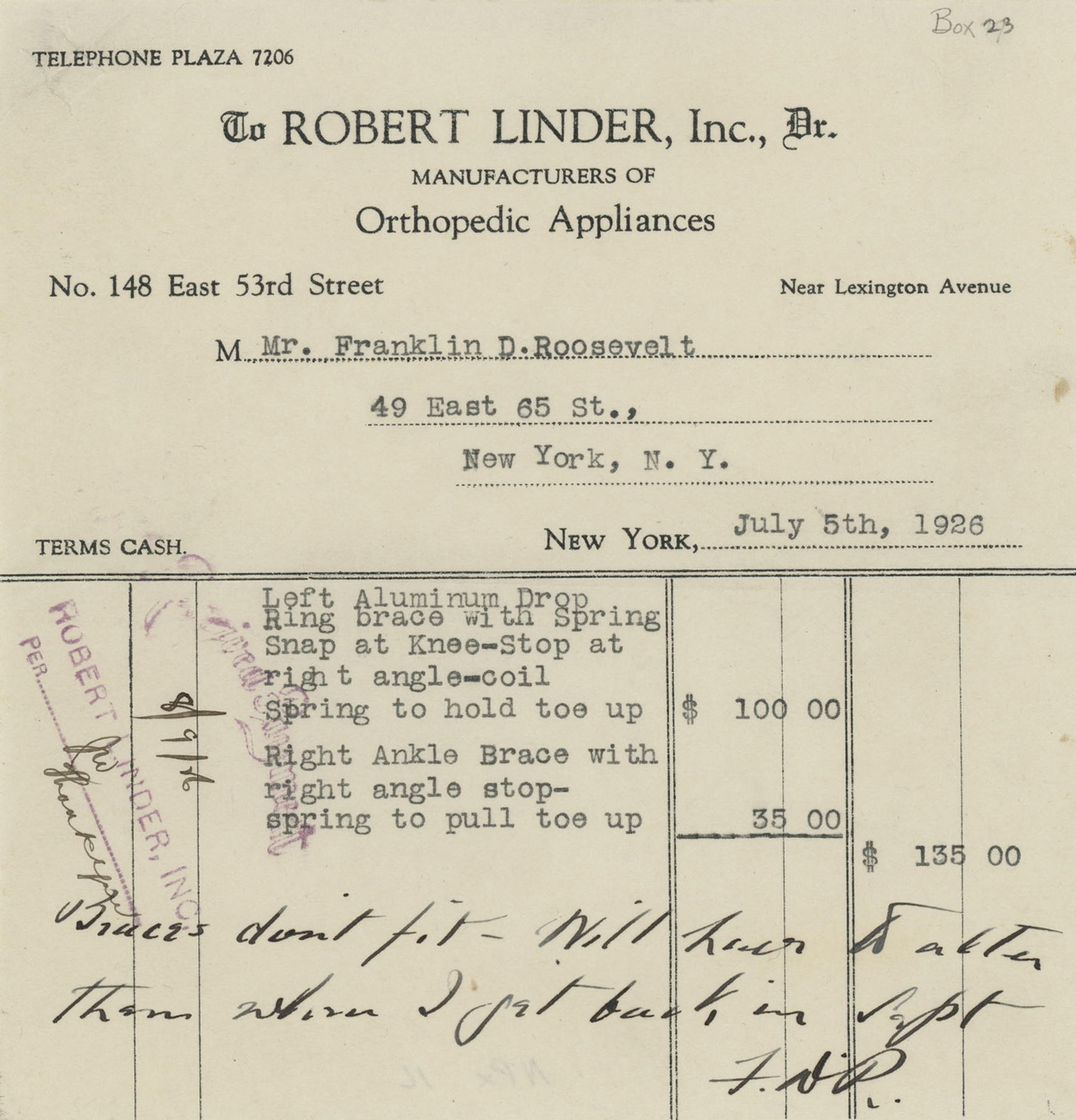 Visualització del contingut web
Visualització del contingut web

Introduction
Franklin D. Roosevelt was the 32nd President of the United States. Not only did he serve an unprecedented four terms in office, but he was also the first president with a significant physical disability. FDR was diagnosed with infantile paralysis, better known as polio, in 1921, at the age of 39. Although dealing with this crippling disease was difficult, many believe that his personal struggles helped shape FDR, both as a man and as a president.
 Visualització del contingut web
Visualització del contingut web
Polio Strikes
Coming from a wealthy family, FDR was privileged to enjoy his summers at the Campobello Island family cottage that was purchased by his parents in New Brunswick, Canada. It was at this site that FDR manifested the symptoms of “the insidious and deadly enemy” known as infantile paralysis. No one is certain of the circumstances leading to his contraction of polio, many believe he was exposed to the virus at a Boy Scout camp in New York just prior to going to Campobello.
 Visualització del contingut web
Visualització del contingut web
During the summer of 1921, FDR was enjoying a day of sailing on his yacht when he suddenly fell overboard into the icy waters of the Bay of Fundy, which ironically felt paralyzing to his body. The following day, FDR complained of lower back pain and went for a swim in hopes to ease the soreness. As the day progressed, he could feel his legs becoming weaker and by the third day, he could no longer hold his own weight. His skin quickly became very sensitive and eventually even a slight breeze across his body caused great distress.
Eleanor, who couldn’t bear to see her husband in such anguish, began to contact a handful of doctors, hoping one of them would be able to find a remedy to his unknown infirmity. One of these doctors was Dr. Keen who insisted the issue stemmed from a blood clot located in the lower spinal cord and recommended that he receive lumbar massages daily in order to help circulation. Days later, FDR was notified by Dr. Keen that his earlier diagnosis was incorrect and instead he claimed the distress was being caused by spinal lesion. The massage therapy continued but did not prove to be successful in curing the paralysis.
On August 25, 1921, another physician, Dr. Robert Lovett, diagnosed FDR with infantile paralysis (i.e. polio). At that time, polio had no known cure and often resulted in full or partial paralysis and the erosion of one’s motor skills. Lovett, who was an expert on the disease, insisted Franklin stop the massages, as they were not helping the situation and possibly making it worse; he instead suggested that he take hot baths.
Both FDR and Eleanor were surprised by this verdict, as it was uncommon for a middle aged person to contract polio. Most cases of the disease were acquired during infancy, but most children become immune to the disease by the age of four. Lovett explained that in order for a person to combat poliomyelitis, they must be in good emotional and physical health and have a healthy immune system. This made FDR rethink the actuality of having the disease since he could recall frequently becoming ill as a young boy, but for the past few years he had been leading a stressful life in politics that may have weakened his immunity. At the young age of thirty-nine, FDR became a victim of infantile paralysis.
Recovery and Rehabilitation
It was during fall of 1921, when FDR made the decision to remove himself from political life in order to begin his rehabilitation process at his home in Hyde Park, New York. For several years, his main focus shifted from politics to recovering from his paralysis. FDR began routinely swimming three times a week in the Astor pool and in the pond. He had realized that his legs could support the weight of his body in water with ease and used swimming as his main exercise. By the winter of that year, his arms regained strength, his nervous system was functioning normally, and his stomach and lower back were getting stronger (Gallagher 23).
In January 1922, FDR was fit with braces that locked in at the knee and continued the length of his leg, and by the spring of that year he could stand with assistance. FDR made a plan that one day he would walk the length of his driveway, which was a quarter-mile long. Although he never accomplished the task, he used it as a training procedure, working himself to the bone in hopes that he would be able to walk again if he continued exercising.
Due to his bright personality, FDR insisted that he be surrounded by “good cheer” throughout his rehab process. He was known for exercising constantly, even when he was surrounded by friends. He would often have people watch him and provide company as he exercised and would carry out a conversation with them despite devoting all his effort to moving.
FDR also involved his children and family with his daily exercise rituals. At first, his children were heartbroken seeing their father in such a vulnerable state, struggling to move. Eventually they became comfortable around his condition and were proactive in helping him and involving themselves with his rehabilitation process. Eleanor recalled, “The perfect naturalness with which the children accepted his limitations though they had always known him as an active person, helped him tremendously in his own acceptance of them” (Roosevelt, Autobiography 142).
 Visualització del contingut web
Visualització del contingut web
 Visualització del contingut web
Visualització del contingut web
Warm Springs, Georgia
During his rehabilitation process, FDR was contacted by George Foster Peabody, a friend who knew of his recent polio attack. Peabody recently learned of an incident where a young man by the name of Louis Joseph, who was stricken by infantile paralysis, was cured by the “healing waters” of Warm Springs. After hearing of this story, he recommended the Warm Springs facility to FDR, hoping he too would become miraculously cured by its medicinal waters.
In 1924, FDR made a trip to the Georgia resort with high hopes that the mineral water in the springs could treat his paralysis. The spring’s water came from Pine Mountain and was known to be rich in mineral content and extremely pure. Although the waters did not restore FDR to ultimate health, his continued visits throughout his political life resulted in an increase in the resort’s popularity and business.
In 1926, Warm Springs was having financial issues. As its favorite visitor, FDR couldn’t allow the facility to close down; instead, he bought the facility for $200,000 and transformed it into a rehabilitation center for polio patients like himself. The following year, the Warm Springs Foundation was considered a permanent hydrotherapeutic center by the American Orthopedic Association.
Above: Home movie footage of various scenes, circa 1928, showing areas around the treatment facility at Warm Springs, GA. Included in this silent footage are shots of FDR swimming, receiving therapy, and attending picnics.
 Visualització del contingut web
Visualització del contingut web
Return to Political Life
FDR made remarkable progress in Hyde Park and Warm Springs, and all his time was well spent during his rehabilitation period. His efforts and exercises clearly paid off, but he still remained a paraplegic. Roosevelt had such faith that one day he would be able to walk again. His stubborn confidence resulted in a personal ultimatum: he either needed to accept the progress he had made and return to politics or give up his political dreams in hopes of breaking out of this stagnant phase of recovery.
Eleanor also played a huge role in convincing FDR to resume his political career. As his wife and co-pilot, she knew he would not be happy in the end if he had decided to terminate his activity in politics. FDR’s close friend and political advisor, Louis Howe, also urged FDR to participate in politics again. Though this decision to return to the political world was supported by two people he respected, it was also looked down upon by the person he cared about the most, his mother. She became very concerned with his health and suggested that he retire completely from his hectic life as a politician. Of course if it had not been for Eleanor and Howe, America might not have had the experience of having FDR in office, nor anything that stemmed from his presidency. (Gallagher 20)
As FDR made his way back into political life, he was unsure how the public would react to his disability. Since his withdrawal from the public eye, not many people knew exactly what had happened to FDR. There were many rumors concerning his health and his physical state.
All of this made it even more difficult for FDR to stay emotionally strong and confident while making his way back into the limelight. His first attempt to regain political interest was to support New York State Governor Al Smith in the 1924 Democratic Convention. This was FDR’s first public appearance since his polio attack and everyone was curious about his condition.
FDR had expected the public to treat him like any other paraplegic at the time, with ignorance. During the 1920’s, disability was frowned upon. Often disabled family members were put into asylums and banished from the family. The disabled were not employable and were often removed from society.
As FDR began to move up on the political ladder, Americans were not shaken by his disability. More citizens were sympathetic to his condition rather than embarrassed. Fueled by America’s “good cheer” and acceptance, FDR gained more confidence in his political career and ran for governor of New York in 1928. His disability did not affect his votes and as a result, he held the governorship for two terms until he decided to run for President in the 1932 election.
His political advisors often worried about how successful FDR would be in the election. They feared the words of his opponents and the names people often called him hoping to break his stride. Despite all of this, FDR’s disability was never brought up as a problem throughout his 1932 campaign and presidency and did not affect America’s love for him.
 Visualització del contingut web
Visualització del contingut web
Living with Disability
In private, FDR used a special wheelchair he designed himself. He refused to use a “regular” wheelchair because the chairs of the time were one-size-fits-all, bulky and a nuisance to get around in. Most buildings during his era were not wheelchair accessible; therefore Roosevelt needed something small, appealing, efficient, and discreet. To accomplish this, he used a dining chair and replaced the legs with bicycle-like wheels. The chair was small and could move around tight corners and narrow hallways with ease. His wheelchair did not call a lot of attention since it was made out of something people were used to seeing in their own homes.
Although FDR’s disability did not directly interfere with his role as President, he was not completely comfortable being open about his situation.
Masking his disability in his home was one thing, but the real challenge arose when he was asked to appear in public or deliver a speech. Often he was required to navigate to a podium or area in which he would greet listeners. Of course FDR could have simply chosen to remain in his wheelchair during public events, but he wanted to assure America that he was capable. He never wanted Americans to get the impression that he was helpless, so it was important to him to at least seem as if he could walk.
FDR devised a method of “walking” in which he used a cane and the arm of his son or advisor for balance. He would maneuver his hips and swing is legs forward in a swaying motion to make it appear as if he was walking. Stairs were also a challenge for FDR, he learned to support his weight with just his arms, holding himself up as if he were on parallel bars, and swing his way down toward the next step.
FDR requested that the press avoid photographing him walking, maneuvering, or being transferred from his car. The stipulation was accepted by most reporters and photographers but periodically someone would not comply. The Secret Service was assigned to purposely interfere with anyone who tried to snap a photo of FDR in a “disabled or weak” state (Gallagher 94).
 Visualització del contingut web
Visualització del contingut web
Legacy
Although FDR made the choice to put his paralysis on the back burner in order to return to political life, he never gave up on the cause. Throughout his presidency, FDR made sure that he put effort into assisting those who suffered from polio.
After ten years of setting up Warm Springs so that it became the prime place for polio patients to receive therapy, FDR faced funding issues with the foundation. The first Birthday Ball in 1934 was held in commemoration of FDR’s birthday. He urged people in his honor to make monetary donations to the facility and ended up raising one million dollars for the Georgia Warm Springs Foundation.
The Birthday Balls continued in order to support both Warm Springs and FDR’s National Foundation for Infantile Paralysis which he created four years later in 1938. The fundraising for the National Foundation evolved into what we now know as the March of Dimes. This was a fund-raiser in which all of its proceeds went to the National Foundation for Infantile Paralysis. The annual continuation of this occasion eventually funded the research for the Salk vaccine to treat polio; unfortunately FDR never lived to see it.
FDR’s disability was often called a “blessing in disguise” by his wife. Eleanor had a way of looking at the big picture instead of worrying over the small stuff. She understood that the battles her husband fought in life were often more than what they seemed.
FDR’s illness threw him into a category frowned upon by most of the American population. The way he viewed himself as a person, father and politician despite his limitations helped others to change the way they viewed others crippled by disease or disability. Disabled or not, FDR became a symbol of strength and perseverance to Americans, showing them that “You gain strength, courage and confidence by every experience in which you really stop to look fear in the face. You are able to say to yourself, ‘I have lived through this horror. I can take the next thing that comes along.’…You must do the thing you think you cannot do” (Roosevelt, You Learn by Living 29-30).
 Visualització del contingut web
Visualització del contingut web
Primary Sources
- Franklin D. Roosevelt Family, Business and Personal Papers..
- Franklin D. Roosevelt President's Personal File..
Secondary Sources
- Gallagher, Hugh Gregory. FDR's Splendid Deception. Revised Edition ed. 1985. Arlington: Vandamere Press, 1994...
- Roosevelt, Anna Eleanor. The Autobiography of Eleanor Roosevelt. First Edition ed. New York: Harper & Brothers Publishers, 1937...
- Roosevelt, Eleanor. You Learn By Living. New York: Harper & Brothers Publishers, 1960...






